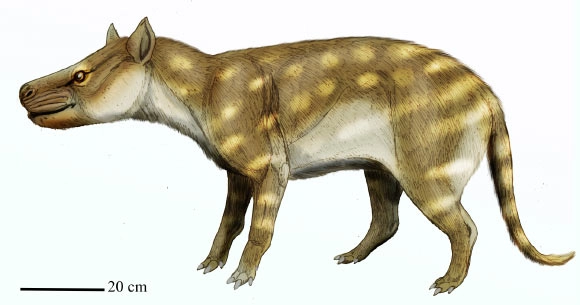During the Paleocene-Eocene Thermal Maximum (PETM), a period of geological rapid warming and aridification approximately 56 million years ago, a flesh-eating mesonychid mammal called Dissacus praenuntius responded in a surprising way it started eating more bones.

Dissacus praenuntius. Image credit: DiBgd / CC BY 4.0.
What happened during the PETM very much mirrors whats happening today and what will happen in the future, said Andrew Schwartz, a doctoral student at Rutgers, the State University of New Jersey-New Brunswick.
Were seeing the same patterns. Carbon dioxide levels are rising, temperatures are higher and ecosystems are being disrupted.
In their research, Schwartz and his colleagues used a technique called dental microwear texture analysis to study the tiny pits and scratches left on fossilized teeth of Dissacus praenuntius , a species of mammal in the extinct family Mesonychidae.
Ranging from 12 to 20 kg, this ancient omnivore was about the size of a jackal or a coyote.
The animal was fairly common in early Cenozoic forests and likely consumed a mix of meat and other food sources like fruits and insects.
They looked superficially like wolves with oversized heads, Schwartz said.
Their teeth were kind of like hyenas. But they had little tiny hooves on each of their toes.
Before this period of rising temperatures, Dissacus praenuntius had a diet similar to modern cheetahs, eating mostly tough flesh.
But during and after this ancient period, its teeth showed signs of crunching harder materials, such as bones.
We found that their dental microwear looked more like that of lions and hyenas.
That suggests they were eating more brittle food, which were probably bones, because their usual prey was smaller or less available.
This dietary shift happened alongside a modest reduction in body size, likely because of food scarcity.
While earlier hypotheses blamed shrinking animals on hotter temperatures alone, this latest research suggests that limited food played a bigger role, Schwartz said.
This period of rapid global warming lasted about 200,000 years, but the changes it triggered were fast and dramatic.
Studies of the past like his can offer practical lessons for today and what comes next.
One of the best ways to know whats going to happen in the future is to look back at the past. How did animals change? How did ecosystems respond?
The findings also highlight the importance of dietary flexibility. Animals that can eat a variety of foods are more likely to survive environmental stress.
In the short term, its great to be the best at what you do, Schwartz said.
But in the long term, its risky. Generalists, meaning animals that are good at a lot of things, are more likely to survive when the environment changes.
Such an insight may be helpful for modern conservation biologists, allowing them to identify which species today may be most vulnerable.
Animals with narrow diets, such as pandas, may struggle as their habitats shrink. But adaptable species, including jackals or raccoons, might fare better.
We already see this happening, Schwartz said.
In my earlier research, jackals in Africa started eating more bones and insects over time, probably because of habitat loss and climate stress.
The study also showed that rapid climate warming as seen during the ancient past can lead to major changes in ecosystems, including shifts in available prey and changes in predator behavior.
This may suggest that modern climate change could similarly disrupt food webs and force animals to adapt, or risk extinction.
Even though Dissacus praenuntius was a successful and adaptable animal that lived for about 15 million years, it eventually went extinct, Schwartz said.
Scientists think this happened because of changes in the environment and competition from other animals.
The study was published in June 2025 in the journal Palaeogeography, Palaeoclimatology, Palaeoecology.
_____
Andrew Schwartz et al. 2025. Dietary change across the Paleocene-Eocene Thermal Maximum in the mesonychid Dissacus praenuntius. Palaeogeography, Palaeoclimatology, Palaeoecology 675: 113089; doi: 10.1016/j.palaeo.2025.113089



